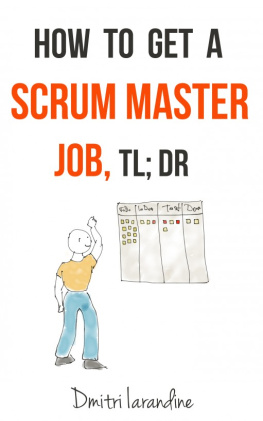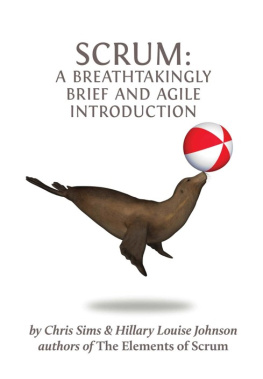All information contained in this book has been presented to the best of our knowledge and
belief and has been checked several times. Nevertheless, there is always a residual risk that
either an error has crept in. Neither the author nor the publisher can be held liable for this.
Impressum
PREFERENTIAL NOTES
Professional Scrum Master (PSM ) and Professional Scrum Product Owner (PSPO ) and Professional Scrum Developer (PSD ) are trademarks of Scrum.org.
This book does not claim any rights to the mentioned trademarks, nor can any guarantees be given for the correctness of the book content. The information provided has been compiled to the best of our knowledge and belief, based on the current state of knowledge. For better readability, the references in the book text have been omitted. However, they are always included.
Bibliografische Information der Deutschen Nationalbibliothek:
Die Deutsche Nationalbibliothek verzeichnet diese Publikation in der
Deutschen Nationalbibliografie; detaillierte bibliografische Daten sind im
Internet ber www.dnb.de abrufbar.
2020 Markus Marfurt
Herstellung und Verlag: BoD Books on Demand GmbH, Norderstedt, Germany
ISBN: 978-3-7431-2907-8
Inhaltsverzeichnis
SCRUM AND AGILE
In most cases, project management is based on the waterfall model (or a comparable approach). This means that before the start of the project or at the beginning of the project, a plan is drawn up for the entire implementation as complete as possible. All conceivable obstacles are taken into account and possible risks are minimized as far as possible. As soon as the project plan is completely prepared, the implementation can begin. In this context, the goal is that the project result predominantly corresponds to what was specified in the underlying planning and the associated requirements documents. The customer (whether internal or external) receives the developed product at the end.
It is an everyday experience that this development approach is associated with considerable risks, especially in the case of projects of longer duration or those with a higher degree of complexity. On the one hand, there is always a certain basic risk as to whether what was originally specified corresponds to what is really needed. Furthermore, there is a risk that the team that has to implement a requirement may understand it in a completely different way than what the client intended. Other challenges include the fact that requirements can change during the course of the project (because the customer needs something else or because certain conditions have changed).
The major weakness of such a development approach is that the customer's involvement during the development period is very low. His knowledge and expertise as a future user are hardly integrated.
Scrum has a completely different approach here. The framework, developed by Ken Schwaber and Jeff Sutherland and first presented at the OOPSLA conference in 1995, is based on constant interaction with the customer and his feedback. Since it is based on the exchange and gain of experience through this feedback, it is also called empirical.
The advantages of such an approach are risk and cost reduction.
Empirical = based on experience.
AGILE
Agile is based on the Agile Manifesto, which can be found at (www.agilemanifest.org).
Manifesto for Agile Software Development
We are uncovering better ways of developing
software by doing it and helping others do it.
Through this work we have come to value:
Individuals and interactions over processes and tools
Working software over comprehensive documentation
Customer collaboration over contract negotiation
Responding to change over following a plan
That is, while there is value in the items on
the right, we value the items on the left more.
Kent Beck
Mike Beedle
Arie van Bennekum
Alistair Cockburn
Ward Cunningham
Martin Fowler
James Grenning
Jim Highsmith
Andrew Hunt
Ron Jeffries
Jon Kern
Brian Marick
Robert C. Martin
Steve Mellor
Ken Schwaber
Jeff Sutherland
Dave Thomas
The goal was to establish a better way for software development and to define values and principles for it.
The Manifesto, which was published in 2001, was influenced by Scrum among other things, which is also shown by the fact that the two developers of Scrum are also among the first signatories of the Manifesto. Agile is more a philosophy than a method or framework, as is the case with Scrum.
PSM 1 CERTIFICATE AND TESTING
More and more agile development methods and frameworks, also from certificate providers, are coming onto the market and so one might ask why of all things the Scrum certificate should be acquired instead of one of the many others.
The fact that such a large number of people want to acquire the various Scrum certificates - especially the probably best known and most renowned PSM (Professional Scrum Master) certificate - is surely related to the fact that these most likely represent the pure teaching of Scrum and almost all other certificates and approaches can be traced back to it in some way. There are, however, other aspects that make the certificates of scrum.org so highly regarded:
Unlike other certifications, Scrum certificates are not awarded as a bonus for a booked course, but are based solely on an examination conducted by an independent organization (which can also be taken online), in which at least 85% of the questions must be answered correctly. This 85% hurdle represents an additional qualification for certificate holders.
What are the requirements?
- No specific training or course is required to be admitted to the exam.
- If you want to offer courses as an accredited trainer, you have to prove many years of Scrum experience as well as pass several exams, which means that corresponding training courses generally have a high level.
- Since the exam is currently only offered in English, a sufficient understanding of the English language is necessary. Especially the technical terms should be present and clear in English.
- The PSM certificate exam only asks for knowledge of the authentic Scrum framework without any other techniques or characteristics.
- The examination fees of currently 150 US$ can be paid online with credit card, Paypal or similar.
- The certification does not expire. A recertification is therefore not necessary.
Procedure of the test
Shortly after the exam is booked online, Scrum.org will send you a receipt as well as the registration confirmation with a password that you have to enter before the exam starts. To be on the safe side, allow for one day. I received the code within a few minutes.
The exam is an "Open Book" exam. It can be taken online on any PC with internet access. Unlike some other exams, video camera surveillance or going to an examination center is not necessary. Currently IE, Chrome and Safari are fully supported as browsers. It is recommended, however, to verify the currently supported browser versions before taking the exam.
All questions are checkable. There are questions that have only one answer, questions for which a certain number of correct answers are required, and questions where all correct answers must be ticked. Read the questions very carefully. Among other things, there are also questions for which all "NOT APPLICABLE" answers should be marked.
Next page









